Canyon Spectral:ONfly
Wheel Size: 29’’ front / 27.5” rear
Travel:
- Frame: 150 mm
- Fork: 160 mm
Geometry highlights:
- Sizes offered: S, M, L, XL
- Headtube angle: 64°
- Reach (size L): 495 mm
- Chainstay length: 440 mm
Frame material: Carbon fiber
Price: Complete bikes starting at $5,999 USD (build details below)
Blister’s Measured Weight (Canyon Spectral:ONfly, size Medium): 43.4 lbs / 19.7 kg
Test Locations: Colorado, New Mexico
Reviewer: Simon Stewart (6’, 170 lbs / 183 cm, 77.1 kg)
Test Duration: 5 months
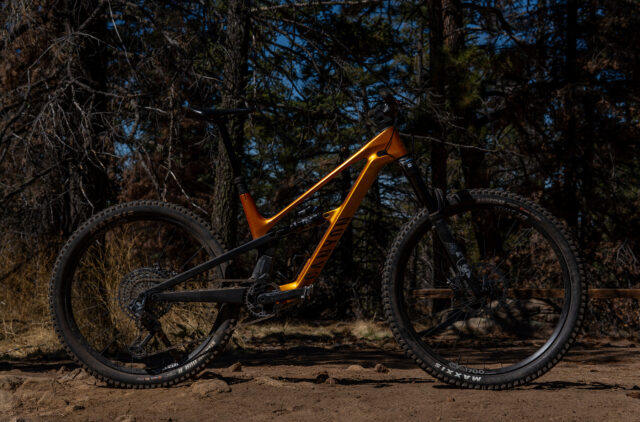
Intro
The Canyon Spectral family has taken many forms over the years, with the Spectral 29 and Spectral 125 proving to be fairly versatile Trail bikes in our testing experience. That focus on all-rounder appeal also applied to the electrified Spectral:ON, which has been in the lineup for several years as a 150mm-travel do-it-all eMTB with a full-power motor.
Now, 2024 has proven to be a big year for the Lightweight eMTB category — check out our recent Head-to-Head video for more on the topic. Canyon has officially joined the party with their new Spectral:ONfly.
Featuring a lightweight TQ HPR50 motor and compact 360 Wh battery, Canyon says the new Spectral:ONfly was designed to blend the speed of an eMTB with the more dynamic handling traits of a regular Trail bike. Let’s get into it to see just how they’ve accomplished their goal.
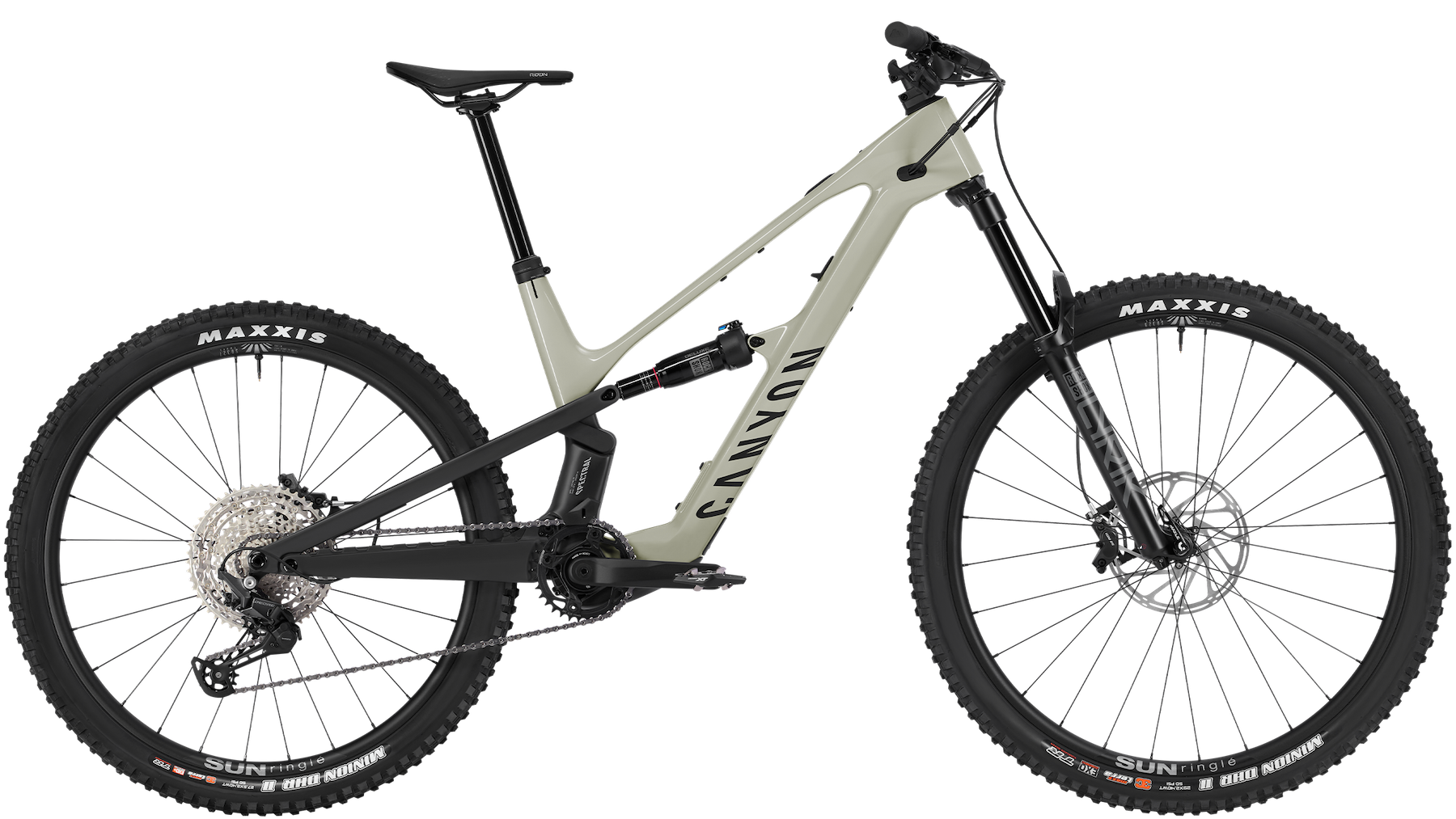
The Frame
The Spectral:ONfly gets 150 mm of rear travel paired with a 160 mm fork, placing it in the more aggressive side of the “Trail bike” class. The frame is a carbon-only affair and comes with dedicated mixed wheel sizes, which seems to be an increasingly common feature of modern eMTBs since it allows for shorter rear centers and a more maneuverable ride characteristic.
Canyon claims that the Spectral:ONfly frame alone weighs 5.8 pounds (2.65 kg), with complete bike weights as low as 40 pounds (18.1 kg) in a size Medium. That’s fairly lightweight but not earth-shatteringly so, but as we’ll get into later, Canyon has done well to choose parts that focus on durability and function rather than trying to hit the lowest possible weight.
Moving onto the suspension design, the Spectral:ONfly sticks with Canyon’s familiar Triple Phase four-bar suspension arrangement, which generates a fairly smooth, linearly progressive leverage curve that flattens out a bit at bottom-out to account for the inherent progression in an air shock. The leverage curve below is a bit confusing in that the axes are positioned in reference to the sag point rather than starting at zero, but the shape of the curve gives an idea of how the Spectral:ONfly’s suspension has been designed.

As for other details, Canyon has eschewed the trend toward flip chips and adjustable headset cups — simplicity is the name of the game with the Spectral:ONfly. It gets threaded inserts at all pivot points to avoid damage to the frame itself in the event of overzealous torquing of pivot bolts, and all bearings are double-sealed for longevity. There’s also room for a bottle below the shock, an accessory mount under the top tube, and protection details throughout.
Canyon has also employed their K.I.S. 2.0 steering stabilizer system on the Spectral:ONfly. We briefly tested an early version of the system several years ago, but for those unfamiliar with the system, K.I.S. uses a simple pair of springs inside the top tube that are attached to the fork’s steerer as part of the headset assembly. These springs essentially try to keep the front wheel straight, creating a stabilizing effect to reduce wheel deflection and wheel flop, and tension is adjustable via a bolt and slider embedded in the top tube. While the system is unique to Canyon, it could absolutely have its merits in stabilizing the front wheel on a heavy eMTB — but skeptics can still remove it fairly easily, too.
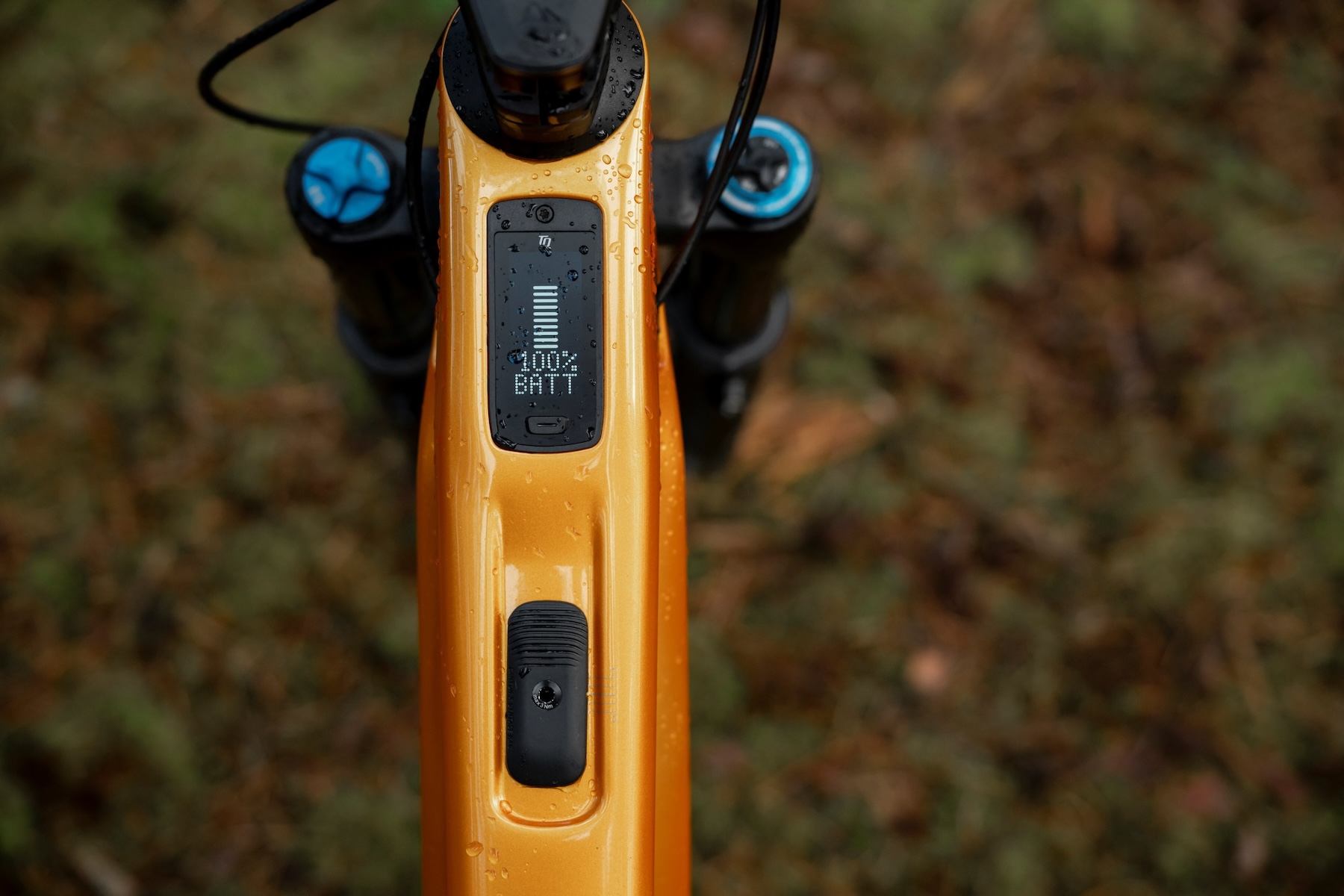

Drive System
While Canyon’s shorter-travel Neuron:ONfly opts for the more powerful Bosch SX motor, Canyon surprised us a bit by opting for a TQ motor in the Spectral:ONfly — it’s the first bike from them to use this system.
The TQ HPR50 is a familiar motor for us, featured on the Trek Slash+ and Fuel EXe. It’s a rather compact little drive unit, packing 50 Nm of torque, 250 W of continuous power, and 300 W peak power. It’s proven to be a quiet and smooth-running motor on those Trek bikes, and we’d expect a similar experience with the Spectral:ONfly.
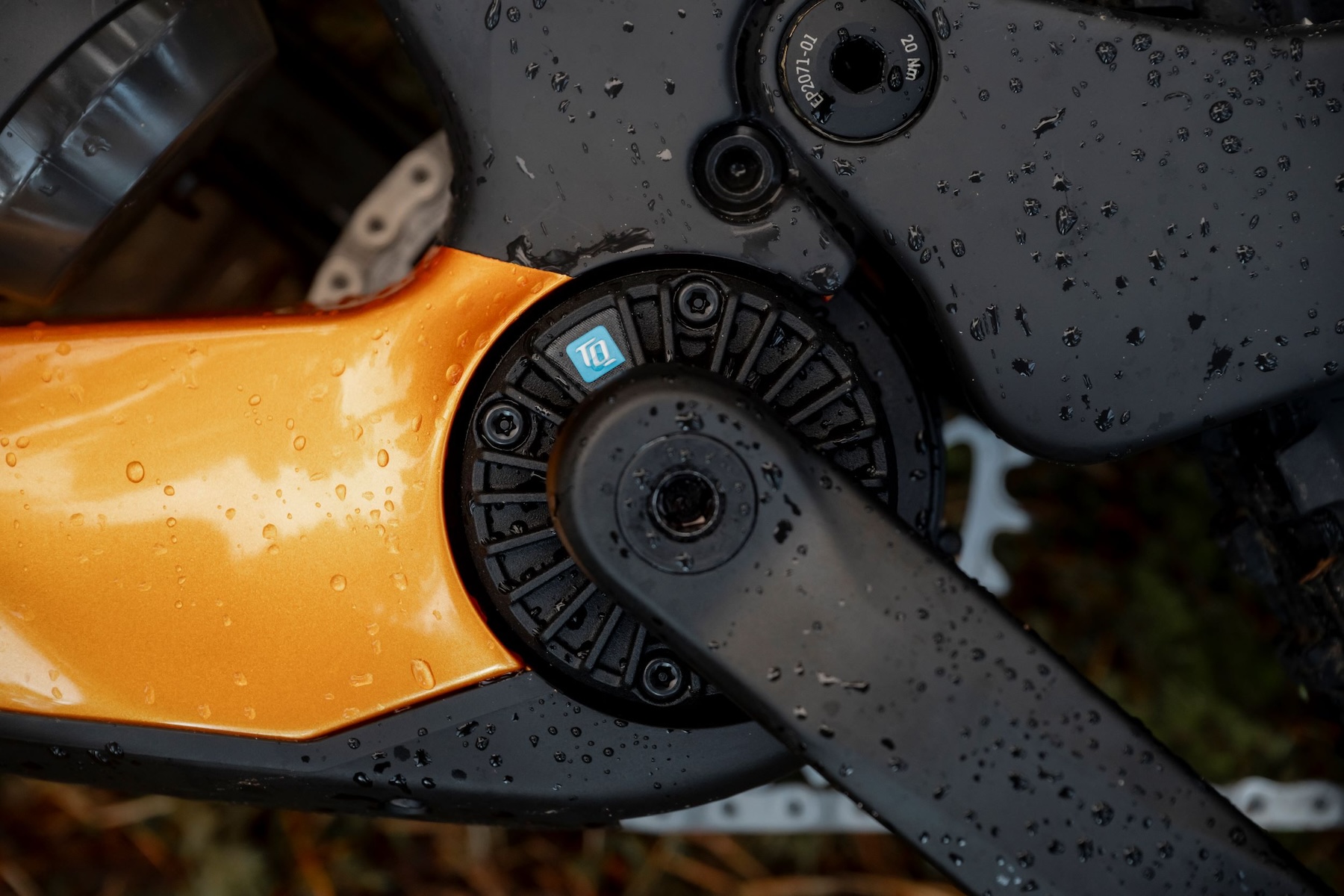
Between the small motor format and 360 Wh battery, the Spectral:ONfly barely looks like an eMTB at all. That smaller battery does mean that its range isn’t likely all that great, and as mentioned in our recent review of the Trek Fuel EXe Aluminum, we’d likely spring for the 160 Wh range extender — fortunately, that’s available as an upgrade from Canyon and fits in the place of the water bottle cage.
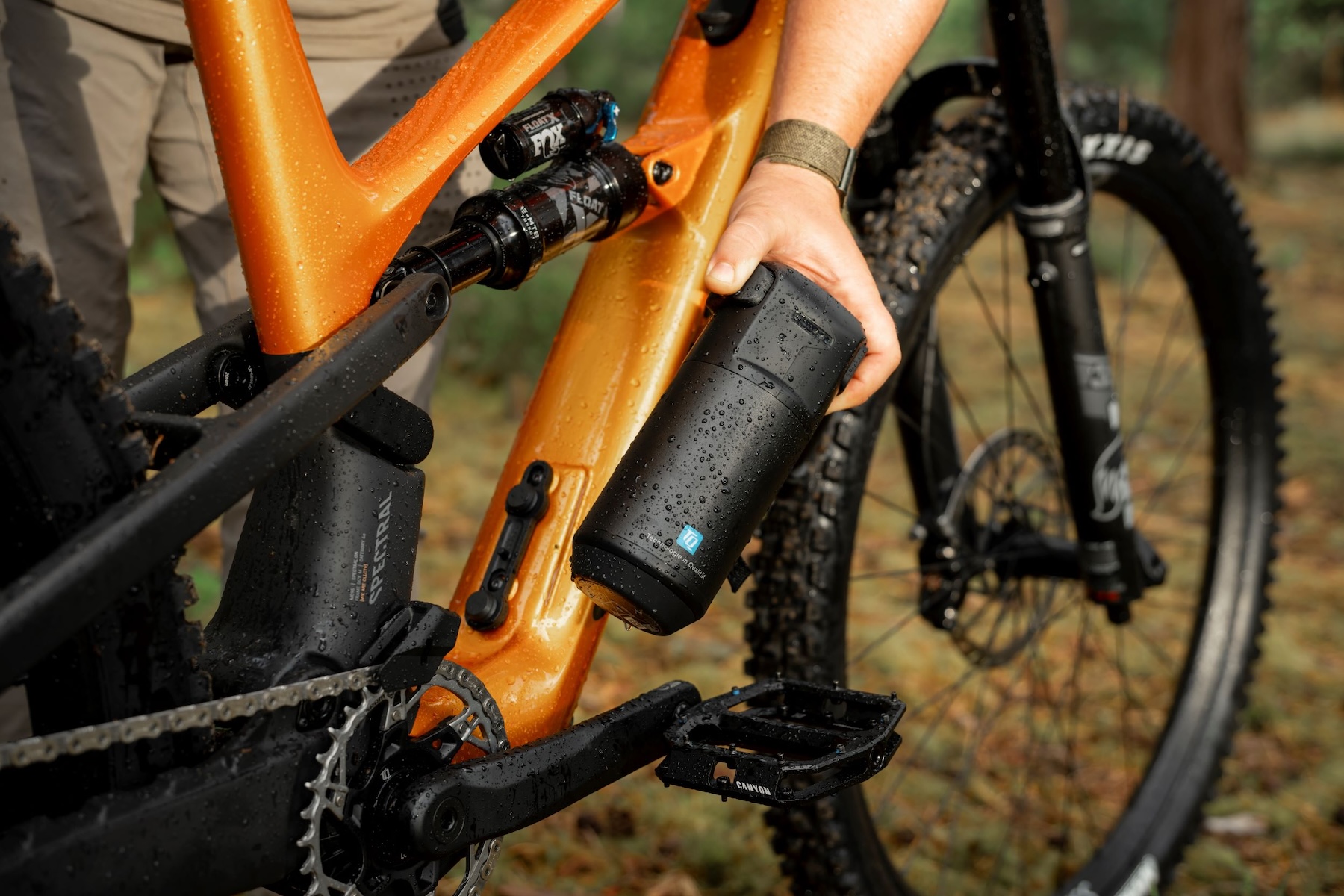
Fit & Geometry
Some of Canyon’s recent bikes in the Trail and Enduro categories have featured some generous sizing (i.e., they’re quite long relative to nominal sizes), and the same trend holds true with the Spectral:ONfly.
While all four sizes get a moderate 64° head tube angle and 440 mm chainstays, the size Large Spectral:ONfly has a 495 mm reach and 648 mm top tube length — both of which are a good 10–20 mm longer than what we typically expect for a “Large.” Its bottom bracket height is fairly low at 342 mm, and the seat tube angle is not all that steep at 76.5°. Riders with particularly long legs should note that the actual seat tube angle is 72.9° on a Large, which could feel a bit overly slack at higher-than-average saddle heights.
Detailed geometry figures are as follows:

The Builds
While there are multiple options available internationally, Canyon is launching the Spectral:ONfly with just two builds here in the US — the CF8 and the CF CLLCTV.
As with most things Canyon, the price points are quite compelling. The $5,999 USD CF8 model gets a RockShox Lyrik fork and Deluxe Select+ shock, and there’s a full Shimano Deore drivetrain paired with Code R brakes. As typical with Canyon, the cockpit and dropper are all house-brand components.
The higher-spec CF CLLCTV (said as “CF collective”) will cost you $7,499 USD and gets several key upgrades. A Fox 38 Performance Elite fork is a good bit burlier than the CF8’s Lyrik, and a GX Transmission handles shifting duties on the CLLCTV build. It also gets you DT Swiss HX1700 LS and nicer SRAM Code Silver Stealth brakes, but otherwise, the Canyon finishing parts remain.
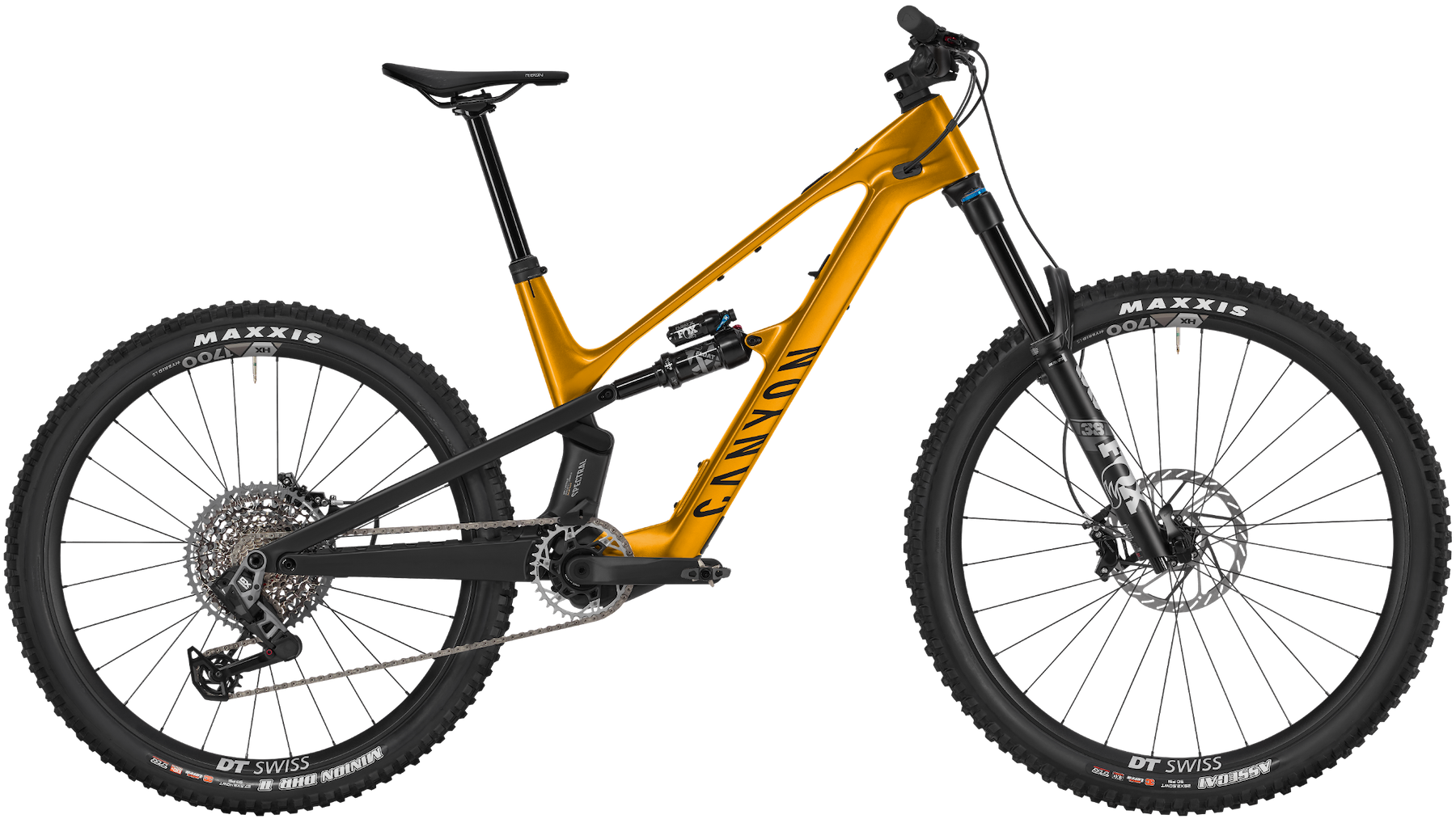
I do want to note a few things hidden in the build details, the first being Canyon’s use of very long dropper post lengths. The size Small Spectral:ONfly gets a 170 mm post, Medium and Large get 200 mm, and XL gets 230 mm — well done there, Canyon. Brake rotors are also properly large at 200 mm front and rear. The only notable letdown is the tire spec, which goes with a Maxxis EXO casing up front and EXO+ casing rear. As far as I’m concerned, EXO isn’t suitable on much outside of XC and very lightweight Trail bikes, let alone an eMTB — and even EXO+ feels a bit light duty, at least on the rear tire.
Here are the highlights of the two builds:
- Drivetrain: Shimano Deore
- Brakes: SRAM Code R (200 mm rotors)
- Fork: RockShox Lyrik Base (160 mm)
- Shock: RockShox Deluxe Select+
- Wheels: SunRingle Trail Expert 329/327
- Dropper Post: Canyon G5 (S: 170 mm, M–L: 200 mm, XL: 230 mm)
- Drivetrain: SRAM GX Transmission
- Brakes: SRAM Code Silver Stealth (200 mm rotors)
- Fork: Fox 38 Performance Elite (160 mm)
- Shock: Fox Float X Performance
- Wheels: DT Swiss HX1700 LS
- Dropper Post: Canyon G5 (S: 170 mm, M–L: 200 mm, XL: 230 mm)
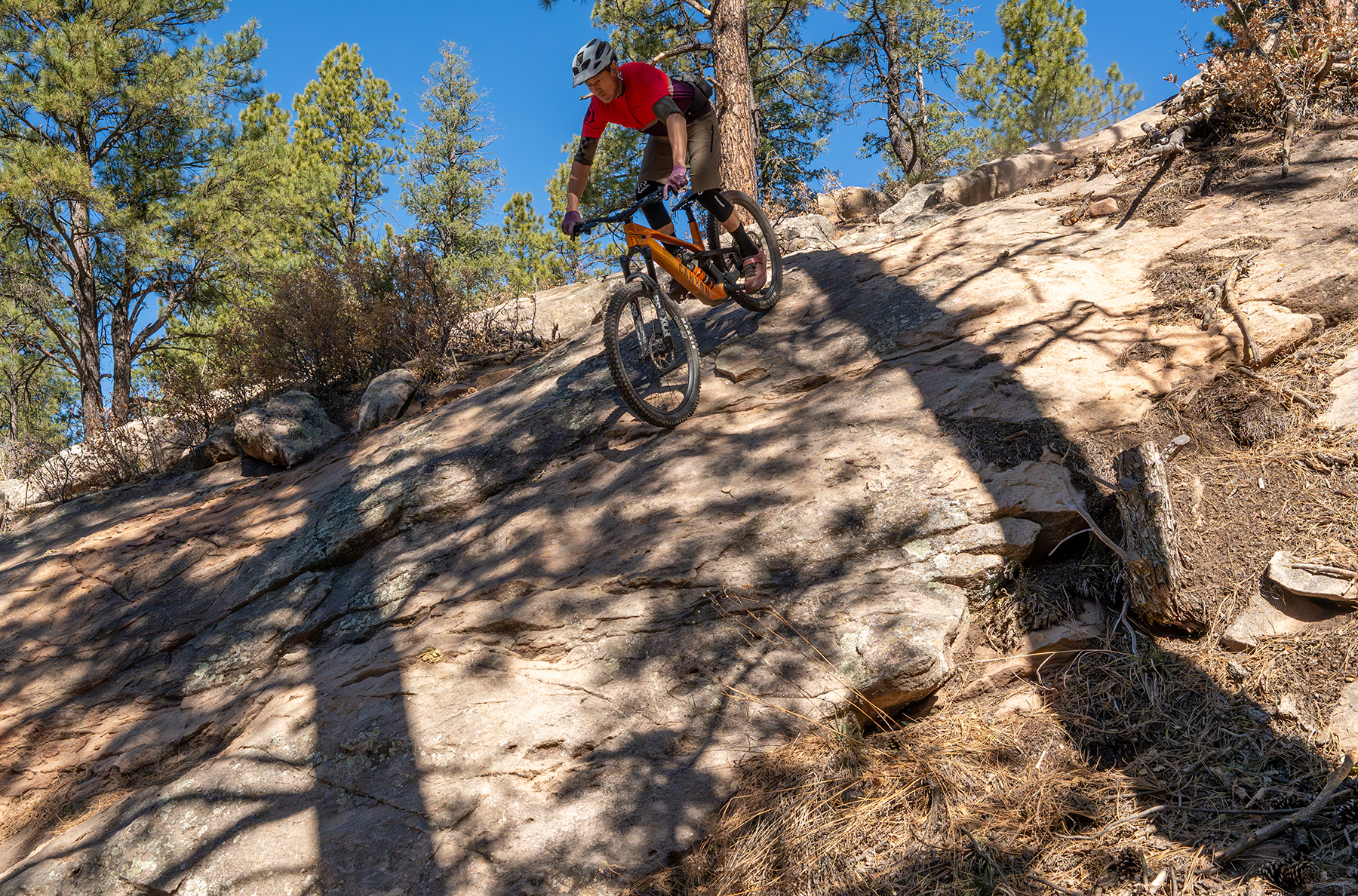
Full Review
I’m a fan of the 150 mm travel light-assist Trail / All-mountain eMTB category, and think bikes with that amount of rear travel can do particularly well with lighter-weight drive systems. But it’s a crowded segment, and some full-power eMTBs with similar travel are only a few pounds, if any, heavier. Canyon’s decision to prioritize low weight by building the Spectral:ONfly around TQ’s HPR50 motor could give it a natural handling edge over heavier full-power bikes, but its small 360 Wh battery and lower power than a lot of the competition could hold it back when it comes to speed, range, and steep climbing performance.
There’s no doubt it’s harder than ever to stand out, and we tested the Spectral:ONfly in both the CF8 and CF CLLCTV builds in varied terrain spread out over two states to dig in and find out if Canyon’s approach to the popular light-assist category is a winner.
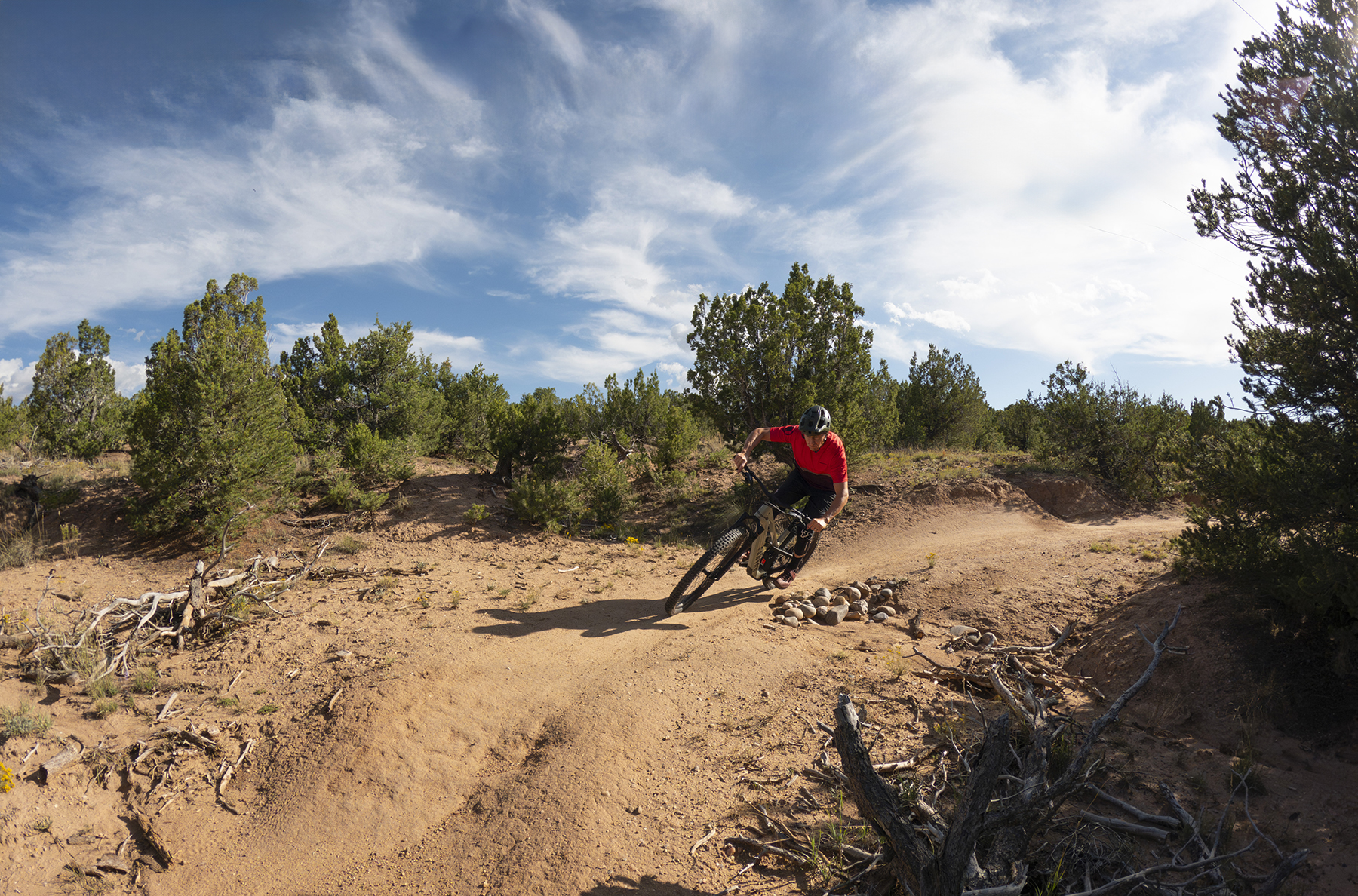
Fit & Sizing
Simon Stewart (6’, 170 lbs / 183 cm, 77 kg): Canyon’s generous sizing for the Spectral:ONfly put me between a size Medium and Large. I say generous because their reach / top tube length numbers are a good 10–20 mm longer than what we typically see for the respective sizes. Given my preferred reach is usually in the range of 475–485 mm, and the Spectral:ONfly’s reach is 470 mm for the Medium and 495 mm for the Large, the fit presented a wee conundrum. However, as we’ve said many times before, the fit is more than just one number, and after studying the rest of the geometry, I settled on the size Medium. Namely, because the 76.5º effective seat tube angle is not too steep, but also because the 72.9º actual seat tube angle, in conjunction with the healthy amount of seat post protrusion for my saddle height on the Medium, would likely slacken the effective seat tube angle some. I assumed the not-too-steep seat angle would help the cockpit feel less cramped with the shorter 470 mm reach.
The tricky thing about Canyon’s sizing is that they are a consumer-direct company, so the opportunity to get on one before buying is limited. I’ve stared at enough geometry charts and ridden enough bikes to be able to make fairly accurate, educated guesses when it comes to fit, but getting on one is still the best bet. Canyon does have a fit calculator on their website, and after punching in my numbers, it recommends a Medium as well, so it seems to be reasonably well-calibrated.
Out of the box, the fit on the Medium is on the compact side, as to be expected given the reach, but it’s not cramped at all. The stack height (629 mm) is around 20 mm lower than I’d typically like, and even if I had gone with the Large (638 mm), that wouldn’t have helped much. Thankfully, my trusty Burgtec Ride High Josh Bryceland Signature Bar has 50 mm of rise, which puts my hands right in my sweet spot.
I think the compact fit suits the Spectral:ONfly’s personality, but it also holds it back in a few areas, too. More on that below.
K.I.S.
Canyon’s K.I.S. is a proprietary steering centering mechanism that uses two opposing springs to help center the front wheel. I committed to giving the K.I.S. system a solid go and rode it for the first two months of the review. Initially, I was thrown off by it. I was consistently understeering in corners and having to brake mid-corner to correct my line, usually losing all my speed in the process. I think the added (but barely perceivable) increase in steering effort is enough to make me need to rewire over 25 years of steering muscle memory.
As I got more acclimated to the K.I.S. system, it got better, to the point where I was cornering like I’m used to. But in certain situations, it still felt unnatural. On top of that, every time I got on a different review bike without the K.I.S. system, I had to spend time re-adjusting.
So, my take is that the K.I.S. system does affect handling, sometimes in a positive way, and sometimes not. On steep climbs, it makes a small difference in helping keep the front wheel from wandering, but it wasn’t enough to prevent me from having to slide forward on the saddle. I can remember one occasion where I’m sure it saved me from a crash when I was riding on snow-covered trails, but I can also think of more times where I think it almost caused me to crash. Ultimately, I felt like it was complicating something I’ve never had an issue with, so I removed it. Additionally, I think it makes more sense if you’re only riding the bike it’s on, and not switching between bikes regularly. Canyon realizes it’s not for everyone, and includes a blanking plate that covers the adjuster slot should you decide to remove it.
The rest of the review is written with the K.I.S. system removed.
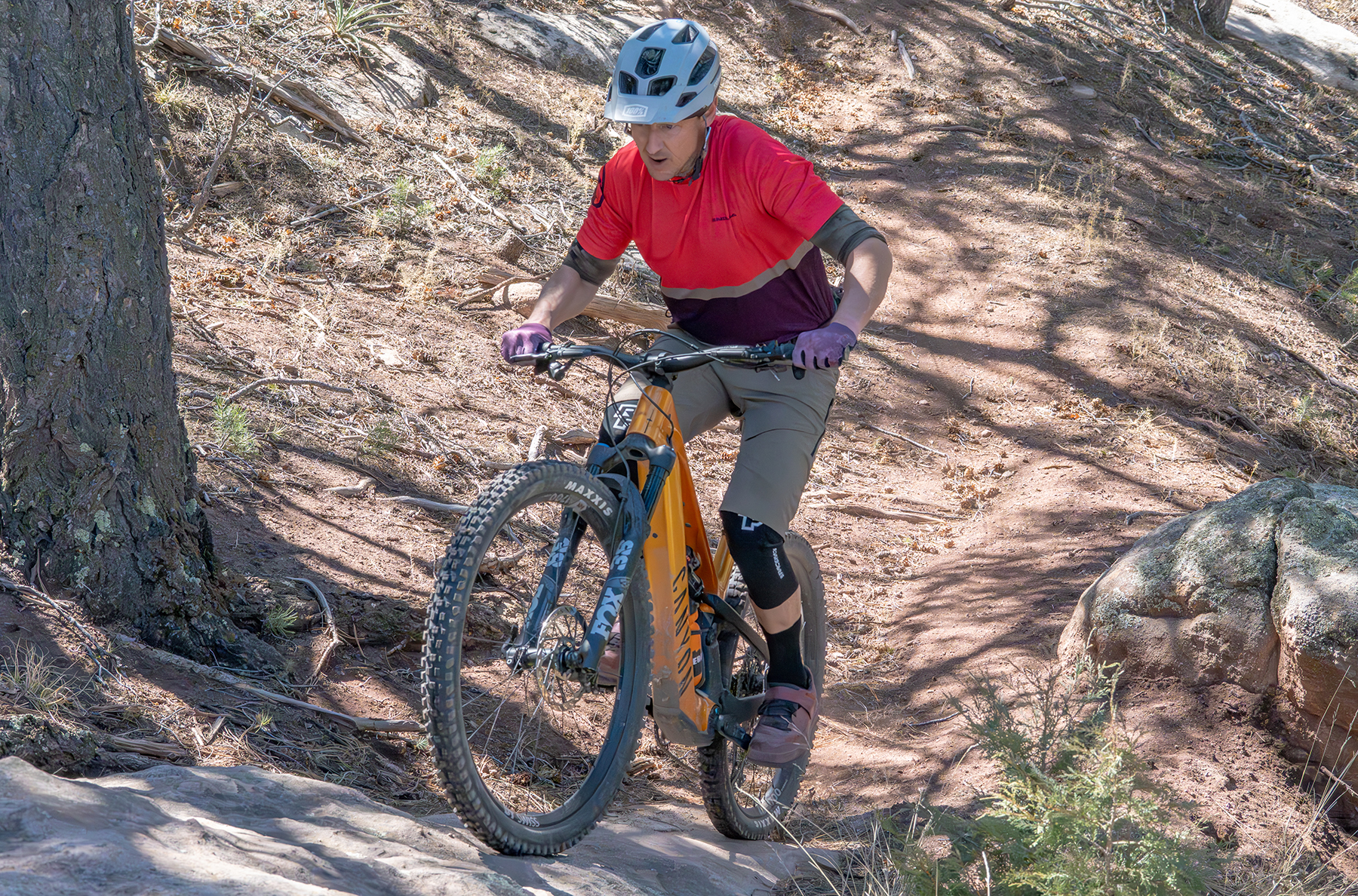
Climbing
The Spectral:ONfly benefits from the TQ HPR50’s smooth and natural power delivery, which creates a calm, controlled climbing demeanor. Some full-power eMTBs can require a fair bit of skill to manage when on loose, technical terrain, and can sometimes feel a bit frantic. The Spectral:ONfly, on the other hand, feels more like you’re just super fit, rather than riding a scaled-down dirt bike. The suspension manages the motor’s power well, and traction is easy to regulate even when in the highest assist mode.
On long fire road climbs, the seated climbing position is more compact than I would like, and it would be nice to have more room to change body position. To be clear, it’s not cramped, exactly; I would just prefer a little more room on long climbs. Also, I typically don’t find a steep effective seat tube angle to be as important on eMTBs because climbing speeds are usually a good bit higher than non-powered bikes, which helps keep the front end from wandering, rather than depending on the rider’s body position to weight the front wheel. But, because the TQ HPR50 is on the lower power side, the Spectral:ONfly doesn’t climb with enough speed to offset what feels like a fairly slack effective seat tube angle. I mentioned in the Fit section that the not-too-steep effective seat tube angle was one of the reasons why the Spectral:ONfly doesn’t feel cramped, but although it helps with the fit, I have to slide significantly forward on the saddle on steep sections of trail.
Because the TQ motor has relatively low power (360 watts of peak power), the Spectral:ONfly is not my first choice for climbing impossibly steep, technical trails. If climbing incredibly difficult terrain — stuff that is unrideable on regular non-powered bikes — is a priority, then a full-power eMTB is essential. I have yet to ride a light-assist eMTB that can match a full-power eMTB on my benchmark technical climbing trails. Overall, the Spectral:ONfly is a good climber (but what eMTB isn’t); it just doesn’t particularly stand out, either.
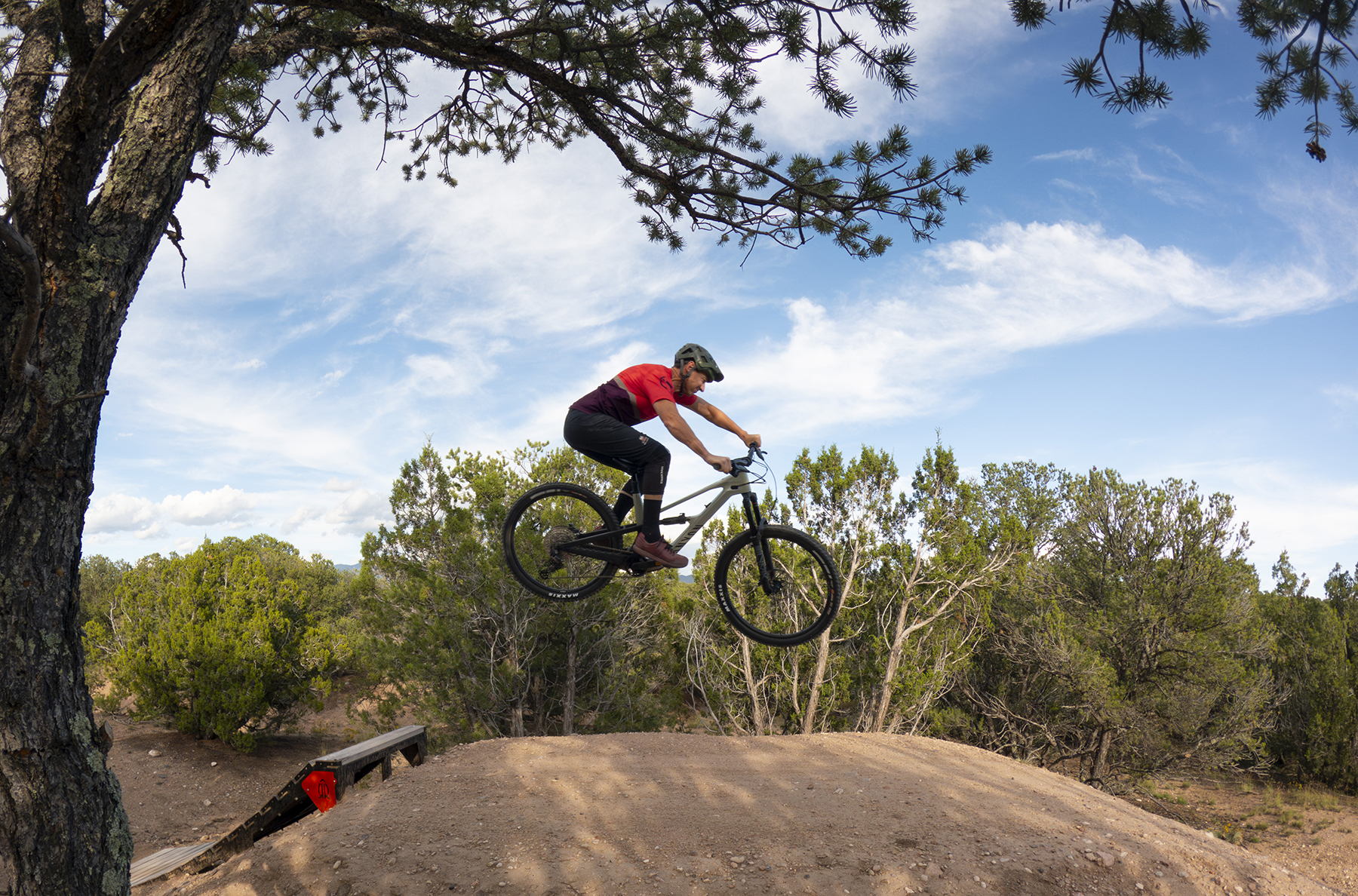
Descending
Thanks to an overall light-ish weight (43.4 lbs / 19.7 kg), the Spectral:ONfly is more maneuverable, feels lighter on its feet, and changes direction quicker than the majority of full-power eMTBs I’ve ridden. That is basically the whole idea behind the light-assist eMTB category: strike a middle ground between regular non-powered bikes and full-power eMTBs by making them handle as close to a non-powered bike as possible, while still having some motor assistance. After riding a fifty-plus-pound full-power eMTB, the Spectral:ONfly’s handling advantages are evident right away.
Going downhill, the Spectral:ONfly exhibits a nice mix of playfulness and stability without swaying too far in either direction. Its compact fit puts you in a centered position when standing, and since there isn’t a ton of room to move around, less dramatic weight shifts seem like they have a more immediate effect, which I find helps the Spectral:ONfly feel responsive and playful. Shifting my weight slightly forward, I find it easy to get the back end predictably loose in corners. Shifting it rearward and the Spectral:ONfly likes to manual, and doesn’t require a hefty pull on the bars like some eMTBs do, thanks to the added battery weight in the downtube. On that note, the TQ HPR50’s 360 Wh battery is one of the lightest batteries available, which contributes to the Spectral:ONfly’s easy-to-throw-around nature.
The Spectral:ONfly likes to be ridden aggressively and rewards you with a predictable, yet fun and playful personality that has you looking off to the sides for features to play around on. But, it’s not one-dimensional either, as it (especially the CF CLLCTV build — more on that in a minute) can also charge the fast line. Now, light-assist longer travel eMTBs like the Mondraker Dune XR and Trek Slash+ are far more capable of high-speed assaults in gnarly terrain, but, given the Spectral:ONfly’s modest travel, I found that it performed better than expected when pushed hard on steep, rocky descents.
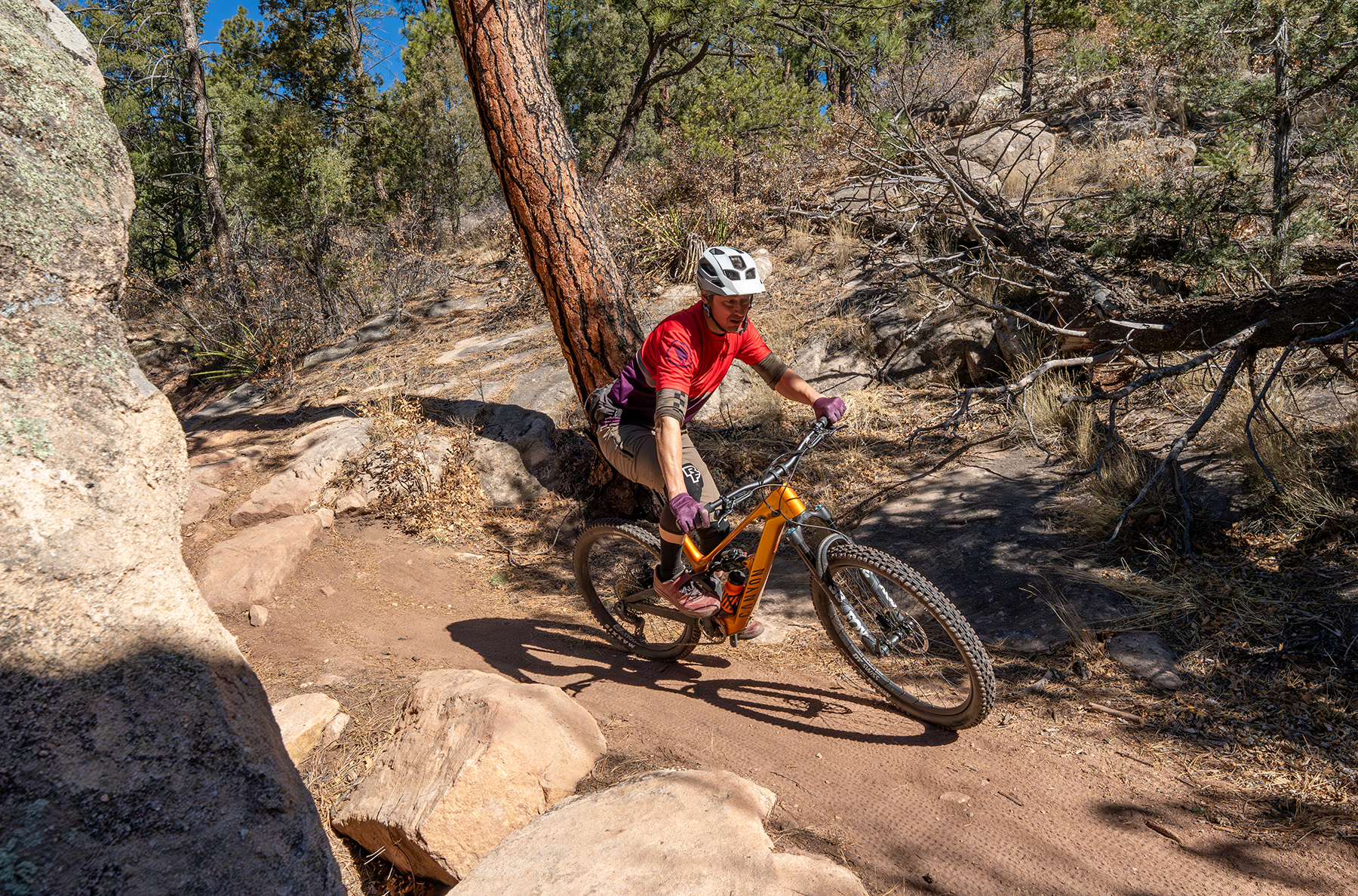
The Builds
Both the Spectral:ONfly CF8 and CF CLLCTV builds feature full carbon frames (yes, swingarm, too) and provide hard-to-beat value for what they offer — and that’s at full retail (which seems like a thing of the past these days). Factor in the crazy low sale pricing Canyon is currently running at the time of publication, and they are even more enticing. We spent time on the two builds offered to the U.S market and found them to be well-thought-out, and again, really quite inexpensive given the respective parts spec.
The Spectral:ONfly CF8 build at $5,999 (current sale price: $3,899) comes nicely equipped with a RockShox Lyrik fork, Deluxe Select+ shock, and SRAM Code R brakes, but that’s it from the SRAM catalog. Canyon chose a Shimano Deore 6100 12-speed drivetrain to handle the shifting duties, which, when shifting under the extra load of the TQ HPR50 motor, is a bit on the clunky side. The SRAM GX Transmission spec’d on the CF CLLCTV build is noticeably smoother shifting, which is not surprising given the attention SRAM put on shifting performance under load for their Transmission groupsets. Rounding out the build is a set of Sunringle Trail Expert wheels that have been solid performers and have held up well to the abuse of an eMTB.
The Spectral:ONfly CF CLLCTV build, at $7,499 (current sale price: $4,899), upgrades the RockShox suspension to a FOX 38 Performance Elite out front and FOX Float X Performance in the rear. As mentioned above, the CF CLLCTV build features a SRAM GX Transmission group. I typically prefer SRAM’s AXS Transmission drivetrains on eMTBs, and the Spectral:ONfly is no exception. It just does such a nice job of managing the added power and torque of an eMTB when shifting under load.
As already mentioned, we tested the Spectral:ONfly in the CF CLLCTV and CF8 builds. Both trend towards being more downhill-focused overall. However, the much burlier Fox 38 fork on the CF CLLTV (the CF8 has a Rockshox Lyrik) makes a massive difference when charging through chunky terrain — it’s kind of night and day how much more stable it is, plus it corners more precisely, and generally speaking changes the Spectral:ONfly CF CLLCTV into a way rowdier, more Enduro focused descender.
The Fox Float X rear shock on the CF CLLCTV was less noticeable out back in relation to the Rockshox Super Deluxe rear shock on the CF8, with the exception of having improved bottom-out control, and a touch more support in the middle of the stroke — I experienced a good few reasonably harsh bottom-outs with the CF8, but didn’t have any on the CF CLLCTV. While the extra weight of the 38 is noticeable, in my opinion, the benefits far outweigh the negatives, plus the Float X is better suited to the type of riding the Spectral:ONfly encourages. Simply put, if you’re the type of rider who likes to ride steep, gnarly trails, the extra cost for the CF CLLCTV build is 100%.
Besides the suspension and drivetrain upgrades, the CF CLLCTV build also gets a DT Swiss HX1700 wheelset. And while they performed similarly on the trail to the Sunringle wheels on the CF8, as well as weighing about the same, I’ll take a DT star ratchet hub any day when managing the added stress of an eMTB drive system.
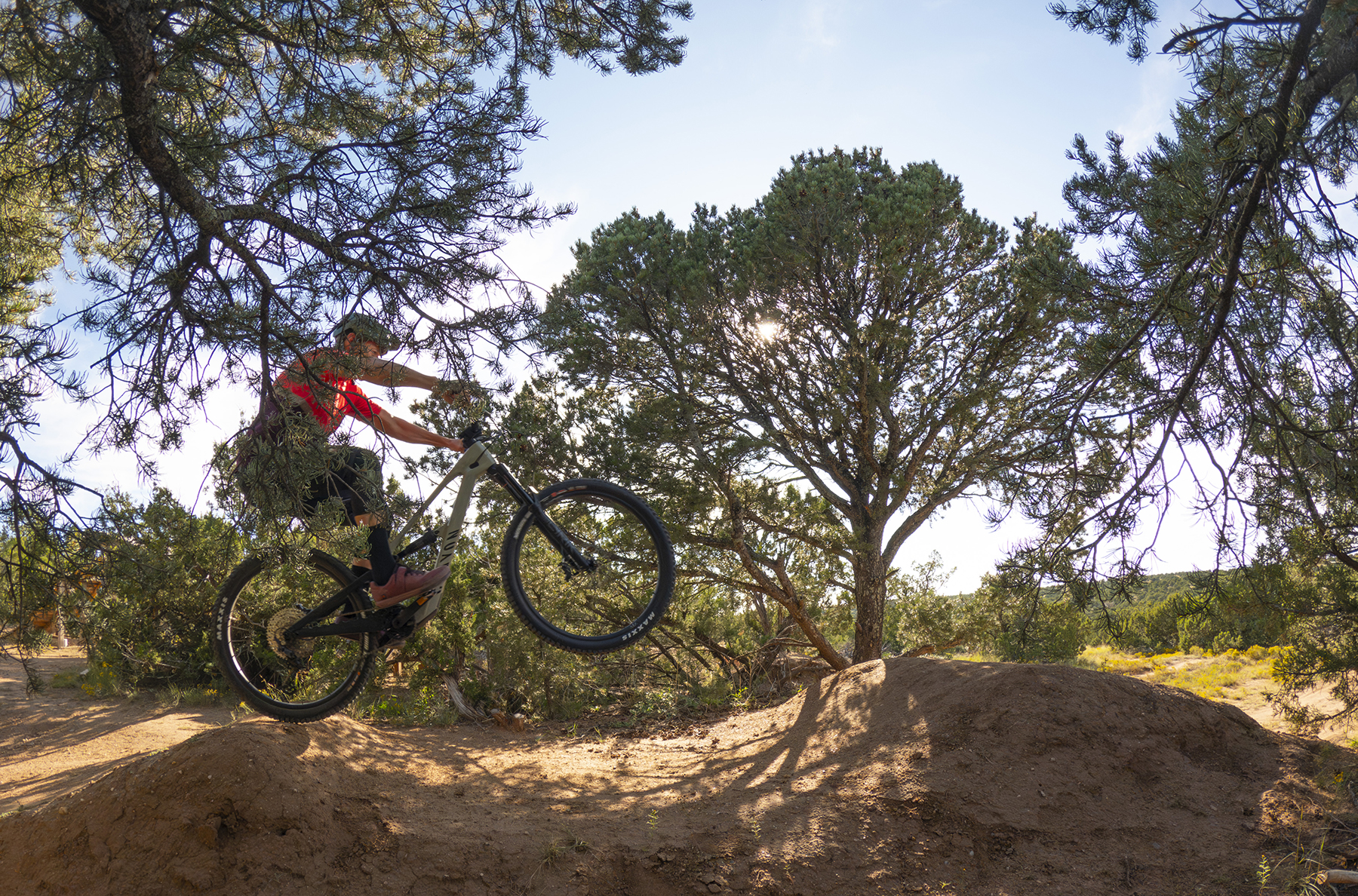
Drive System and Range
We’ve now spent considerable time on the TQ HPR50 drive system in multiple review bikes, and it remains one of our favorite light-assist motors. For more specifics, check out our Full Reviews of the Trek Slash+, Trek Fuel EXe, and BMC URS AMP LT. TQ has recently released the HPR60 drive system, which is the direct successor to the HPR50, and my guess is that future Spectral:ONflys will get the updated drive system. Perhaps that is a reason for the current crazy low pricing…
My experience with the TQ HPR50 in the Spectral:ONfly mostly matches my experience on other eMTBs with it — it’s still the quietest system I’ve been on, and its smooth, natural power delivery is wonderfully easy to manage. The 360 Wh battery, while contributing to the overall lightweight of the system, is massively range-challenged. I’ve run out of power on the Spectral:ONfly more than any other eMTB I’ve reviewed. Thankfully, that is a solvable problem since TQ offers a 160 Wh range extender. But be forewarned, those 160 watt-hours do not come cheap, with an MSRP of over $600. By comparison, Bosch’s Powermore range extender stores 250 Wh of energy for about the same price.
Where the “mostly” comes into play is the Spectral:ONfly’s HPR50 drive system I’ve been on that has had a reliability issue. Unfortunately, it developed an issue where it would cut power after a few pedal strokes from starting, and display a speed sensor error code. I’ve had speed sensor faults on many different drive systems, all of which were easily remedied by either cleaning the sensor and magnet, repositioning the sensor closer to the magnet, or even replacing a magnet that had fallen off (usually attached to the brake disc or wheel). However, none of the usual fixes worked on the TQ drive system, so it went back to Canyon for further diagnostics. We’ll update this review once we hear back about what was causing the problem.
Who’s It For?
I think the Spectral:ONfly is a good choice for riders who like to put in a good bit of their own power rather than letting the drive system do the majority of the work, and are after an eMTB with handling characteristics that are closer to non-powered bikes. Also, with the absence of any flip chips or other geometry adjustments, the Spectral:ONfly presents a simple, uncomplicated approach that will resonate with folks who may find adjustable geometry a bit overwhelming. The Spectral:ONfly isn’t the best choice if seeking out impossibly hard climbs is in the cards, or for long adventure rides (without a range extender), and makes more sense for fast laps in varied terrain, from more mundane to aggressively technical (CF CLLCTV).
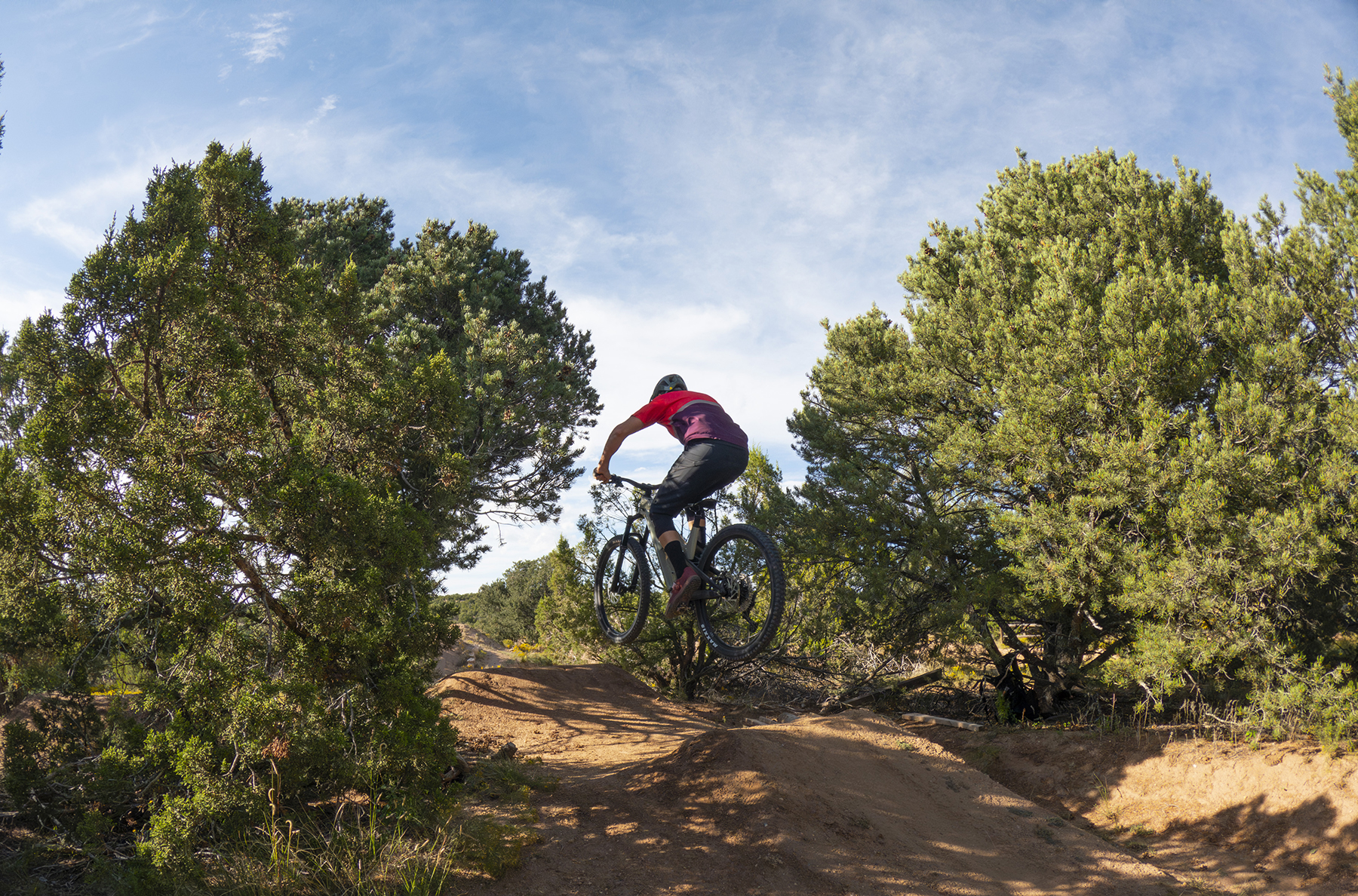
Bottom Line
The Canyon Spectral:ONfly is an easy-to-get-along-with eMTB: it packages the excellent TQ HPR50 drive system with an uncomplicated approach and a playful, engaging personality that I think makes the Spectral:ONfly a compelling option, even before factoring in the high-value build specs.
Deep Dive Comparisons
BLISTER+ members and those who purchase our Digital Access Pass can check out our Deep Dive comparisons linked below. Get our Digital Access Pass to view all our Deep Dives and Flash Reviews, or become a BLISTER+ member today to get access to that and a LOT more, including the best worldwide Outdoor Injury Insurance, exclusive deals and discounts on skis, personalized gear recommendations from us, and much more.

Deep Dive: Canyon Spectral:ONfly
We compare the Spectral:ONfly to the Norco Fluid VLT 130, Rocky Mountain Instinct Powerplay SL, Santa Cruz Heckler SL, Pivot Shuttle SL, and Pivot Shuttle SL/AM.
Blister’s Flash Reviews and Deep Dives are accessible to those who purchase one of our paid subscriptions
To get our comprehensive Deep Dives and our initial, unfiltered reports on new gear, become a member and receive many other services, deals, and discounts.
If you’re already an active member, please log in.
(If you’re already logged in and a member in good standing and seeing this message in error, please refresh this page in your browser.)

Nice bike. Big fan of the TQ, but not mullet-only capability.
Looking “like a boss” there Simon. Great review with lots of details and experience!
I’d love to see bikes where you can completely remove the battery for a simple ride or a day in the bike park, and only install it when extra support really makes sense.
Check out the Transition Relay, which is exactly what you’re looking for. However, even with the battery removed, there will still be some mechanical resistance from the motor.
Any update on motor battery issue?